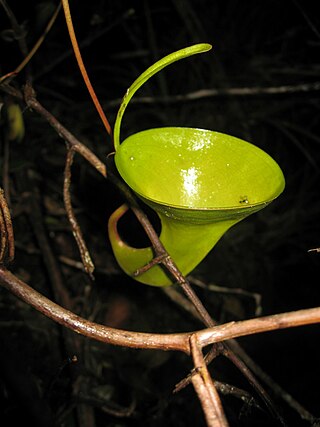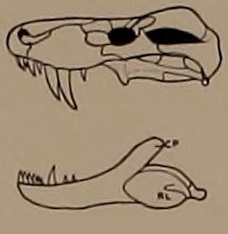Related Research Articles

Myrciaria dubia, commonly known as camu-camu, caçari, araçá-d'água, or camocamo, is a species of plant in the family Myrtaceae. It is a small bushy riverside tree from the Amazon rainforest in Peru and Brazil, which grows to a height of 3–5 m (9.8–16.4 ft) and bears a red/purple cherry-like fruit. It is a close relative of the false jaboticaba and the guavaberry or rumberry. As much as 2 to 3% of the fresh fruit by weight is vitamin C.

Nepenthes dubia is a tropical pitcher plant endemic to the Indonesian island of Sumatra, where it grows at an altitude of 1600–2700 m above sea level. The specific epithet dubia is the Latin word for "doubtful".

Nepenthes inermis is a tropical pitcher plant endemic to the Indonesian island of Sumatra. The specific epithet inermis is Latin for "unarmed" and refers to the upper pitchers of this species, which are unique in that they completely lack a peristome.

Trochosaurus is a dubious genus of therocephalian therapsid from South Africa based upon specimens of Lycosuchidae. Three species of Trochosaurus have appeared in literature, T. intermedius, T. major, and T. dirus. The genus Trochosaurus and all three species are considered nomen dubia today, while the specimens referred to them are regarded as Lycosuchidae incertae sedis.

The Ctenuchina are a subtribe of moths in the family Erebidae.

Belemnia is a genus of moths in the subfamily Arctiinae. The genus was erected by Francis Walker in 1854. Species are found in Central and South America.

Blaptica dubia, the dubia roach, orange-spotted roach, Guyana spotted roach, or Argentinian wood roach, is a medium-sized species of cockroach which grows to around 40–45 mm (1.6–1.8 in).
Dubia is a plural of the Latin word dubium and may refer to:

The dubious dtella, native Australian house gecko, or dubious four-clawed gecko is a species of gecko in the genus Gehyra, native to Northeastern Australia. The lizard is found in a variety of habitats, including acacia and eucalyptus woodlands, and in human-developed habitats, such as house walls in urban areas. Its urban presence makes it known as a common house gecko in Queensland. These geckos are often confused with the Asian common house gecko, which was introduced to Australia from Indonesia, but G. dubia has distinct rounded feet and quieter calls.

Epipsestis is a genus of moths belonging to the subfamily Thyatirinae of the Drepanidae. It was erected by Shōnen Matsumura in 1921.

Epipsestis dubia is a moth of the family Drepanidae first described by Warren in 1888. It is found from Kashmir to northern Vietnam and Taiwan.
Belemnia alpha is a moth of the subfamily Arctiinae. It was described by Herbert Druce in 1884. It is found in Panama.
Belemnia eryx is a moth of the subfamily Arctiinae. It was described by Johan Christian Fabricius in 1775. It is found in Venezuela, Bolivia, Argentina, Brazil, Colombia and Peru.

Belemnia inaurata is a moth of the subfamily Arctiinae. It was described by Sulzer in 1776. It is found in Mexico, Guatemala, Honduras, Panama and Colombia.
Belemnia mygdon is a moth of the subfamily Arctiinae. It was described by Herbert Druce in 1900. It is found in Colombia.
Belemnia ochriplaga is a moth of the subfamily Arctiinae. It was described by George Hampson in 1901. It is found in Brazil.
Belemnia pavonia is a moth of the subfamily Arctiinae. It was described by William Trowbridge Merrifield Forbes in 1939. It is found in Panama.
Belemnia trotschi is a moth of the subfamily Arctiinae first described by Herbert Druce in 1884. It is found in Panama and Costa Rica.

Tanaoctena dubia, the Karamu shoot borer or Coprosma shoot borer moth, is a moth in the family Galacticidae. It was described by Philpott in 1931. It is found in New Zealand.
Rhipidomella is an extinct genus of brachiopod belonging to the order Orthida and family Rhipidomellidae. Specimens have been found in Carboniferous to Permian beds in southwest Asia, the Moscow Basin, and North America.
References
- ↑ Beccaloni, G.; Scoble, M.; Kitching, I.; Simonsen, T.; Robinson, G.; Pitkin, B.; Hine, A.; Lyal, C., eds. (2003). "Belemnia dubia". The Global Lepidoptera Names Index . Natural History Museum . Retrieved April 27, 2018.